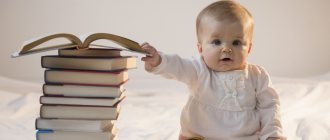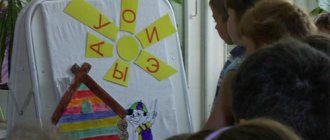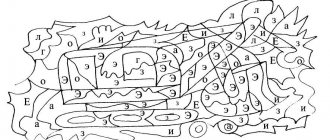GCD for teaching literacy in kindergarten. Senior group
This material is intended for kindergarten teachers.
The GCD summary will be useful in working with children of the senior/preparatory group, the educational area of cognition (learning to read and write). Outline of educational activities for teaching literacy for the senior group of kindergartens (it is more expedient to carry out in subgroups)
Topic.
Introducing children to the word. Goal: to form children’s ideas about the word as an intonation and semantic unit of speech. Program objectives: 1. Familiarize the child with the word. 2. Acquiring the ability to listen attentively to the spoken word. 3. Learn to ask and distinguish the questions “Who is this?”, “What is this?” 4. Fix in children’s speech a word denoting a “living” or “non-living” object. 5. Continue to educate children to speak every word distinctly, clearly, intelligibly. Materials and equipment: player for audio recordings;
a beautifully designed box with riddle pictures in it; doll; teddy bear; photograph of a bear; a set of pictures “Fun exercise”, depicting a human figure in motion; the summary uses the didactic game “Add a word” by the author I. Tokmakova; warm-up by E. and S. Zheleznov “We are stomping, stomping, stomping.” GCD move:
Part I.
- Guys, there are many different objects around us, and we can say something about each object. Now I will show you pictures and ask “What is this?”, and you answer me in one word (pointing to various inanimate objects). Children answer, for example, book, table, ball, etc. - How can you ask about these items? What is this? - And now I’ll ask you differently: “Who is this?” (I show pictures, point to animate objects: a bird, a fish, a cat, I point with my hand at the nanny, at the children, at myself). How can you ask? Who is this? - Now I will name you different objects, and you ask me the question “who?”, “what?” (Thus, I gradually introduce children to the concepts of “living” and “non-living”). — I invite a girl at will, put a doll next to her and ask the children a question. — What is the difference between a girl and a doll? (children name the differences and together come to the conclusion that the girl is alive, and the doll is inanimate, a toy). Then I show an illustration with a bear and a toy bear depicted on it. - Guys, are they any different from each other? We find out that the bear toy is not alive, but the picture depicts a living bear. To summarize: - All words denoting inanimate objects answer the question “what?”, and words denoting living objects answer the question “who?”
Part II.
Physical pause “Fun exercise”, the cards show schematic images of little people in different poses.
Children need to repeat the same movements. Part III.
- Guys, look at what an unusual box I have, it’s not simple and very mysterious, because there are a lot of mysteries for you that are waiting, can’t wait to be helped, finally solved. - Interesting? Then listen carefully to the end of each riddle and answer the questions “who is this?”, “what is this?”. Is this object living or inanimate? •What always goes, but never leaves its place? (hours) •Winter and summer the same color? (spruce) •Do I wake everyone up on time, even though I don’t wind the clock? (cockerel) •Do the red paws pinch the paws? (goose) •She lives in water, has no beak, but does she peck? (fish) •Without a tongue, but speaks, without ears, but will he hear? (phone) Next, I invite the children to come up with or remember a riddle on their own and ask all the children. Children make riddles and guess. This object is called living or inanimate.
Part IV.
Physical pause “We stomp stomp stomp with our feet”, children perform exercises to the music: We stomp stomp stomp with our feet, We clap clap clap with our hands, And we can turn here and there without difficulty.
We will nod our heads, wave our arms together, and turn here and there without difficulty. We will jump high, Jump together so easily, And we will turn here and there without difficulty. Part V
- Now, I will say the word, and you tell me what it means, how you understand it. Listen, book! What does this word mean? (Children's answers). - That's right, you understand well what the word book means, what meaning it has. - Now, I will pronounce different sound combinations. Listen: na, mu, rum, po, ba, etc. Tell me, is it clear what they mean, what meaning they have? (Children's answers). “These are not words, these are just sound combinations, syllables that by themselves, separately from each other, mean nothing, have no meaning.” And when the syllables together they make up words, and each word has a meaning, a meaning. - Let's play the game “Add a word.” A spoon is a spoon, soup is eaten with a spoon...(eat) A cat is a cat, a cat has seven...(kittens). A rag is a rag, I’ll wipe it with a rag... (table). A hat is a hat, I got dressed and went... And I came up with a word, a funny word - plim. And I repeat again - plim, plim, plim. Doesn't jump, doesn't jump plim, plim, plim, And plim, plim, plim doesn't mean anything. — What is “plym”? That's right, this word doesn't mean anything. (Children are asked to say the word “plim” with different intonations). -Now, let's play the game “Name the Word” (goal: learn to distinguish between words denoting an object and words denoting actions). In front of the children, I lay out object pictures on the table depicting a table, a butterfly, a cube, a sitting person, a running child, etc. -Children, look at the pictures and name one word to which you can ask questions: who is this? What is this? What is he doing? (for each correct answer the child receives a picture).
Part VI.
Final. - Thank you, I liked the way we played today. Today we learned so many new things (here you can ask several children what new they learned). Summarize. - Today we learned that all words denoting inanimate objects answer the question “what?”, and living objects answer the question “who?”, we also know that words consist of syllables, and each word has a meaning.
We recommend watching:
Summary of GCD for introducing older preschoolers to the work of the poet Fet Summary of plot-based GCD in physical education for children of the senior group Summary of GCD in the senior group of compensatory orientation GCD in kindergarten for older preschoolers
Similar articles:
Proverbs about the word
Summary of GCD in the senior group on the topic “Communication”
Summary of GCD in the senior group of kindergarten on the topic “Relaxation”
Summary of a lesson on cognition in the senior group on the topic “Dairy products”
Summary of a lesson on cognition in the senior group on the topic “Construction professions”
ECD for preparing children for learning to read and write “Journey to the country of Abvgdeyki”
- January 20, 2016
Competition “My Pedagogical Initiative - 2015”
Nomination “Methodological work in preschool educational institutions”
ECD for preparing children for learning to read and write (senior group) Topic: “Travel to the country of Abvgdeyki.”
Goal : to teach children sound analysis and synthesis of words.
Tasks:
- to form children’s knowledge of vowels and consonants;
- learn to determine the number of syllables in a word;
- learn to correlate sounds and letters;
- develop children's phonemic hearing and visual perception;
- develop children's speech;
- consolidate the ability to determine the presence of a given sound in a word;
- fix graphic images of letters;
- cultivate a desire to learn your native language.
Equipment : Demonstration material: “Locks for sounds”, manual “Herringbone”, magnetic board, flannelgraph with a silhouette of a tree, figures of animals and birds, toys, ball. Handout: pictures with images: bow and hatch, colored squares to indicate sounds in the word scheme, emoticons: sad and happy.
Vocabulary: hatch, crawl, breaststroke.
Progress of the lesson
Educator: Today our group received a letter from the Wise Owl. She invites us to the fairyland “ABVGDEIKU”. Want to? To get to this country we need to cross a magic bridge, but let’s first check if we can take you all there. I will throw the ball to you, and you will catch it, and answer my question; whoever answers correctly will be able to cross the magic bridge.
Ball game. “Catch the ball if you hear the sound r in the word” (sound a, sound k).
Educator: Well done, you all completed the task, which means you can all cross the bridge and get into the land of sounds. (Everyone goes through the bridge).
Educator: In this country of sounds there are two castles, sounds live in them. Look carefully and tell me, do they look alike? What is the difference? What sounds live in the red castle? What sounds live in the blue-green castle? Why is the second castle blue-green? Why is the door to the red castle open? Why is the door to the blue-green castle closed? Well done.
Educator: What else can you build castles from? I will name the material, and the one to whom I throw the ball will name what it will be: 1. - made of straw? – straw; 2. - made of stone? – stone 3. – made of wood? – wooden 4. – glass? – glass 5. – iron? – iron 6. – made of rubber? – rubber 7. – plastic? – plastic 8. – made of brick? – brick.
Articulation gymnastics.
Educator: Now let's try to build a house using our tongue. First, we put up the walls (fence). We will make large, bright windows (windows) in the wall. We will put shutters (sail) on the windows. We’ll build a pipe on the roof (pull your lips into a tube) And now we’ll paint the ceiling, windows (delicious jam, wash the floors (brush your teeth). Our house is ready, you can prepare for the holiday.
Game “Decorate the Christmas tree”.
Educator: What holiday is approaching? How do we celebrate it? (We decorate the Christmas tree). We also have a Christmas tree, but it is not decorated. I suggest decorating our Christmas tree with balls. But these balls are not simple, they have pictures on them. So, having received the ball, you must determine how many syllables are in the name of this picture. If there is one syllable, hang the ball on the topmost triangle, if two syllables - on the second middle triangle, if three syllables - on the largest bottom triangle. (Children check how many syllables are in the names of their pictures and, commenting, hang the balls on the Christmas tree). What a beautiful elegant Christmas tree we have!
Mapping words.
Educator: You and I have worked hard, decorated the Christmas tree, and now sit down at the tables and listen to the riddles of the Wise Owl, and we must compile the answers in the form of a diagram, we will find out what sounds live in these words. They threw off the golden feathers from Yegorushka, Made Yegorushka cry without grief. (Onion) Place a picture of an onion in front of you. How many sounds do you think there are in this word? Why?
There are three boxes under the picture, which means there are three sounds in the word. Look and listen to how to read this word and how the pointer will help me. Now let's try to read it the same way. Listen to how the first sound of Llluk sounds in the word. Repeat the word, emphasizing the first sound. What is he like? (l-consonant, hard, indicated in blue). Listen to what the second sound sounds like -Luuuk, repeat what sound it is (vowel, in red) Guess what the third sound sounds like in the word -LuUK, what is it? (consonant, hard, blue). What word will you get if you replace the letter y in the word onion with the letter y? (Luke).
Take the picture of the hatch. (We perform the same analysis of the word with the word hatch.)
Educator: Now let's play the game "Live Sounds" . Those children who guess my riddles will play. What is the second sound in the word “bow”, what is the first sound, what is the third sound? Now make up a word. Did the children form the word correctly? The sound “K” - name a word based on your sound, the sound “L” - name your brother, the sound “U” - spin around in place. Well done, sounds, you completed the tasks. Put sounds in your houses and sit down.
Articulation game “Guess what vowel sound I will pronounce?” The teacher, without a voice, “pronounces” vowel sounds with his lips alone. The child must guess, then the children “guess” their vowel sounds.
Educator: I suggest you go further. Look, a tree has grown on our way, and little animals are sitting under the tree and don’t know what to do? Let's help them find their places. - Place on the top of the tree a bird whose name begins with the sound [s] (magpie) - Place on the trunk of a tree an animal whose name begins with the sound [b] (squirrel) - Under the tree on the right, plant a bird whose name begins with [y] (duck) - Plant under a tree an animal whose name begins with the sound [k] (cat) - An insect flies above the cat, whose name begins with the sound [o] (wasp) Well done.
We helped all the animals find their places and can return to kindergarten. The owl says thank you and gives you toys. You need to select only those objects whose names contain the sound k (cube, boat, book, pencil, pen, dog, bag, snowflake, butterfly, cat, frog, paint).
It’s time for us to return to the group, but look, our bridge has disappeared somewhere, probably washed away by water. How can we cross to the other side? (Children express opinions). Yes, you can swim across the river. We quickly went down to the river, bent down, washed ourselves, 1, 2, 3, 4 - that’s how nicely we refreshed ourselves. And now we swam together, You need to do this with your hands: Together once is breaststroke, One and the other is crawl, we all swam as one, We look like dolphins. So we swam across the river.
Bottom line.
Educator: Where have we been? What interesting things did you see or learn in the fairyland, what did you like most? The Wise Owl handed me the chest. Let's see what lies there? These are emoticons, look how different they are. There is a happy smiley and a sad one. I suggest you choose your own emoticons. If you liked our trip, it was easy for you to complete the tasks, take a cheerful emoticon, and if you were bored, it was not very easy to complete the tasks - a sad one.
Author: Nishcheva Vera Nikolaevna, teacher at MBDOU kindergarten No. 69 “Malvina”, Tambov.


